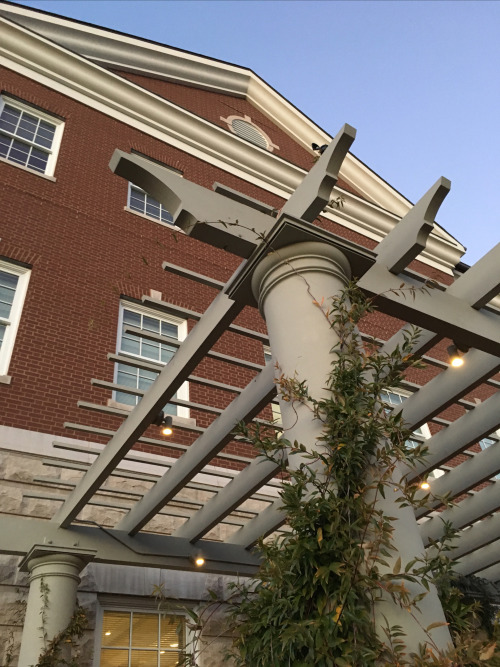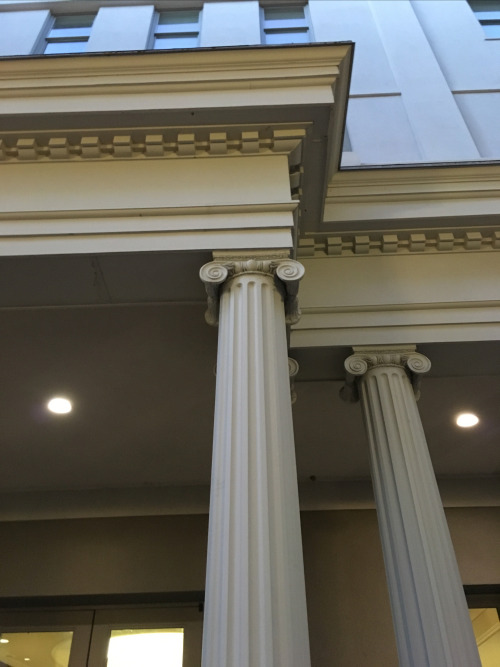#special post



Hunky And Horny
[ Watch him give you more reasons to lust ]



[ Special Post ] One Perfect Hunk
[ See more of this perfectly sculpted hottie ]
• More at
https://instagram.com/datdang.quoc?utm_source=ig_profile_share&igshid=42kldm9pqjyz
Genealogy of Hesiod’s Theogony (a simplified version), handwritten by yours truly for y’all. This stuff is really interesting. I had no idea how complex the divinities were before Kronos. For Bonus points: count how many times there’s a “+ Zeus” on this genealogy!
Post link
I found all three! Belmont definitely likes its Corinthian columns that’s for sure. I had a much harder time finding the Doric columns. I found the Corinthian columns in front of McWhorter Hall, the Ionic columns in front of Inman Hall, and the Doric columns on the patio of the law building. We’ve got some good columns here at belmont, but it wouldn’t hurt to have a little more column diversity if you ask me.
Post link
The Belmont Mansion bears many striking similarities to the Temple of Mars Ultor, the Roman temple that stood as the most important building in the Forum of Augustus. In physical design, many comparisons can be drawn between the Belmont Mansion and the Temple of Mars Ultor, however, there are also many shocking similarities between the histories and backgrounds of the two buildings.
In terms of physical design, similar elements are used with both the mansion and the temple in order to heighten their importance. Both of the buildings are the most iconic, central buildings in their respective contexts. The Belmont Mansion stands at the end of a large open area, surrounded by buildings that lead up to it on both sides. These buildings on the sides all face inward toward the open area, creating a sense of uniformity among them. This makes the Belmont Mansion stand out as important, as it faces inward on the open area from the end of the open area, not the sides. It seems that the entire area is feeding to the building. This can easily be compared to the way that the colonnades along the open sides of the Forum of Augustus lead to the temple of Mars Ultor. These colonnades stand as a uniform border of sorts to the forum, and draw the line of sight and therefore the attention of the visitor to the end of the forum, where the Temple of Mars Ultor stands facing inwards from a different position than the colonnades, emphasizing its importance in the forum.
To contribute to this sense of importance, both the Belmont Mansion and the Temple of Mars Ultor are very frontal in design. It is easy to tell where the main entrance to both buildings are. An even number of Corinthian style columns mark the main entrance to both buildings. In addition to this, both buildings bear sets of stairs at the front. These stairs elevate the building above ground level, further emphasizing their importance as this makes them come across as “ascended” in a way.
The buildings also mimic certain architectural elements that add importance to the entirety of the building. Both the mansion and the temple use painting and dyes to mimic more expensive material than the building is actually made of. Both buildings also utilize false columns. The temple and the mansion both have “columns,” that are not true columns as they actually support nothing. They are simply for decoration and for adding to the importance of the building’s design.
In addition to these physical similarities, the Belmont Mansion and the Temple of Mars Ultor bear interesting similarities in their histories and backgrounds. The Forum of Augustus, and therefore the Temple of Mars Ultor, were built after a brutal civil war in Rome. Augustus’ works when he became emperor were largely trying to promote a golden age and peace for the new empire. His shining Temple to Mars Ultor, though Mars is the god of war, was established as a kind of mask for this dark side of history that was the civil war. The temple was a way of making amends with this violent past and moving on from it toward glory and magnificence. In comparison, the Belmont Mansion was built before the American civil war, but it suffered considerable damage during the war. After the war, however, it was refurbished intensely and made to look almost new. Some may say that the building serves as a kind of mask of violent and dark history as well. It is hard to imagine the brutality of American slavery and the carnage of the American Civil War when looking at the beauty Belmont Mansion. Similarly, it is hard to imagine the violence and chaos of the Roman Civil War when viewing the glory of the Temple of Mars Ultor.
From tiny details to the big-picture historical background, it is truly surprising how many similarities can be found between the Belmont Mansion and the Temple of Mars Ultor. It makes one wonder what old Adelicia Acklen and her husband had in mind when they had it built.
Post link
Green, Peter. Alexander of Macedon, 356-323 B.C.: A Historical Biography. Berkeley and Los Angeles, California: University of California Press, 1991.
This biography of Alexander the Great serves as a brilliant source of information on the man who’s death marked the beginning of the Hellenistic period. The book follows his many conquests and his reign over one of history’s most remembered empires. The author devotes the first chapter to Philip of Macedon, Alexander’s father, in order to set some background to Alexander’s life. Following the assassination of Phillip, the book catalogues in detail the many lands that Alexander conquered, especially those in Asia. The Persian campaigns of Alexander are well documented. These campaigns demonstrate how Greek influence spread to the farthest corners of the Asian and Middle Eastern worlds, explaining important Hellenistic cities such as Alexandria and Ai Khanum. The book mentions mutinies that threatened the empire, especially those in India, and demonstrates Alexander’s impressive ability to keep them under control. This historical biography of Alexanders life follows him all the way up to his death in Babylon in 323 BC.
Post link
In Athens, there reigned a great fighter. His true name is not remembered, for he won so many Olympic boxing matches that he came to be known as Bruiser, the fiercest boxer in the world. He was tall and broad-backed. An average-sized man was dwarfed standing next to him. Men would travel from across the land to fight Bruiser, but one by one he defeated them all with ease.
He had never bled. In all of his years of fighting and living, the magnificent fighter had never been injured to the point of bleeding. In every battle he had ever fought in, not one arrow or sword ever grazed him, though he killed many with arrows and swords of his own. He was indestructible in the eyes of mortals, he was honorable in the eyes of the gods. The gods respected his power and dared not test it. He respected the gods in return, and praised Jupiter with every one of his victories in the Olympic Games. Jupiter was pleased by this and held Bruiser in his favor.
However, there was one god who remained unimpressed by Bruiser’s fighting abilities. Mars, the god of war, regarded himself as the greatest fighter of all, and thought Bruiser to be inferior to him. One day, Mars caught sight of Dásos, wife to Bruiser, and was overcome with lust. Mars took on a human form and descended to the Earth. Mars tried many times to woo her when she was alone in the marketplace, but Dásos remained unmoved and faithful to Bruiser. Offended, Mars stormed away to Dásos’ home, awaiting for her to return. When Dásos returned, Mars ambushed and raped her in her in her home.
Bruiser, who had been hunting that day, returned home and found Mars and Alexandra in bed together. Outrage filled him like it never had before, and he roared loudly at the intruder, “Do you know what you have done!? Do you know who I am!?” Mars lay calmly in Bruiser’s bed, and said “Yes, you are Bruiser, and this is your wife, and I have raped her, but you cannot do anything to stop me. I am Mars, the god of war, and I am the greatest fighter there is. You are not the only one to have never bled in your life.”
At this, Bruiser lost all composure and leaped wildly at Mars. He struck him hard across the face and broke his nose, and Mars bled profusely on the ground. “Now you have bled, and I am the better fighter. Leave now before I harm you further.” Mars was in shock. He had never been struck in a fight ever before. Furious, he revealed himself in his divine form and killed Bruiser where he had been standing over Mars’ human form. Bruiser’s body fell, bleeding in the pool of Mars’ blood.
Mars, still deeply upset and angry over his defeat, turned then to Dásos, who was weeping after seeing her husband killed. He killed her too, and left the home in anger.
Meanwhile, Bruiser’s body lay in his own blood and the blood of Mars. In the blood of Mars there was immortality, and the immortality mixed with Bruiser’s mortal blood, and Bruiser was wakened from death. However, the mix of human and inhuman blood turned Bruiser into a wild beast. When Bruiser was fully revived, he was no longer human, but a great bear. He woke in a haze and saw the body of Dásos, and he roared loudly in sorrow.
Jupiter heard him and felt pity for him, so he decided to revive Dásos. However, he knew that if he simply revived her, she would not recognize Bruiser and would be terrified of him. Therefore, Jupiter turned Dásos into a forest, a thousand trees for Bruiser to make his home. This way, Bruiser could always be with her, and protect her forever. Bruiser became the sacred guardian of Dásos. From that day onward, even Mars’ bravest soldiers trembled at the idea of intruding into the forest, for they knew that Bruiser reigned there, and that he was strong enough to make even Mars bleed.








